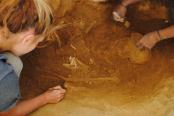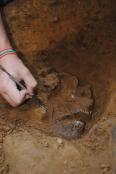CAMPAGNA 2015 |
1° SETTIMANA |
2° SETTIMANA |
3° SETTIMANA |
4° SETTIMANA |
5° SETTIMANA |
6° SETTIMANA |
29 LUGLIO 2015 
Resoconto della giornata di scavo
Area 2000
Today we furthered the exposure of the skeletons revealed yesterday. The medieval grave USk 2658 was fully uncovered and in poor condition. The cranium, both tibias and fibulas, the full right arm, traces of the left ulna and radius, and a left clavicle were present. The fill was cut by another medieval grave cut, showing that it was earlier in the medieval period. USk 2661 was also fully exposed today. Both humeri, both femora, some teeth and the shadow of a cranium was present. The skeleton is in very poor condition. Nonetheless, photos were taken of both of these skeletons, documentation was filled out, and the skeletons will be removed first thing tomorrow. Meanwhile, a fill composed of medium to large rocks and charcoal was also excavated, but the interpretation of what this fill is exactly is still uncertain. We believe that the fill was anthropological by origin due to the rectangular shape of the cut. Photos and documentation was completed for the fill and cut of this unknown rectangular area. In the nook just north of the bell tower a skeleton was found, USk 2663, believing to have belonged to a juvenile based on size. This skeleton, composed of the right tibia and fibula, the left tibia, and the left femur, is positioned underneath the foundation of the bell tower. Due to the relative stratigraphy of this foundation, the skeleton must predate the 10th century and, therefore, is the oldest skeleton found on the site. Tomorrow we will remove the skeletons USk 2658 and 2661 and more excavation will be done to reveal USk 2663. All of sector B will hopefully be cleaned in the course of the day in preparation for area 2000 to be closed for this field season.
Area 3000
Nella porzione sud-orientale del Settore B continua la messa in luce degli inumati USK 3651 e USK 3652, entrambi orientati W-E e deposti in decubito dorsale rispettivamente all’interno delle fosse sepolcrali US -3645 e US – 3647. A nord-est è quasi terminata la messa in evidenza completa dell’individuo USK 3641, anch’esso orientato W-E e sepolto supino in US – 3643. Durante l’esposizione del cranio, in apparizione laterale destra, è stato individuato, in corrispondenza del temporale, un orecchino a cerchietto in bronzo, che sembra confermare il sesso femminile dell’inumato. Nella porzione centro-settentrionale del settore, lungo la sezione della trincea moderna US – 3386, continua l’indagine della fornace US 3560, la cui rimozione completa del riempimento US 3561 ha evidenziato un piano in argilla concotta con al centro l’impronta circolare della base su cui doveva poggiare lo stampo in materiale refrattario per la realizzazione di una campana. Si ipotizza quindi che all’interno del forno avvenisse sia la fusione del bronzo da versare all’interno dello stampo, che la gettata della campana stessa. Il meccanismo di funzionamento del fornace e la sua datazione saranno meglio chiariti nei prossimi giorni.
Today in Area 3000/B, we continued excavation of US3644, exposing more of the skeleton. We exposed most of the skull, ribs, and spinal column. We hope to finish exposing, documenting, and exhuming tomorrow. We continued to excavate US3646, discovering there is a fully articulated skeleton within the fill. We also discovered two additional skulls and a glass piece that is part of a Medieval period lamp. Tomorrow we will continue the excavation of this skeleton as well.
Area 5000
Continua lo scavo e la messa in luce del forno per la campana nella porzione meridionale del settore C. Qui sono state esplorate le piccole buche che circondano la fossa centrale atta a contenere la forma della campana. La scarsa profondità dei tagli ci fa supporre che l'intera struttura sia stata tagliata in orizzontale durante una delle fasi di livellamento del terreno che hanno intercettato tutta la zona all'esterno della chiesa medievale. Tuttavia sul fondo della buca principale si percepisce un canale creato per alimentare il forno di cottura dello stampo in argilla della campana. Il settore B, invece, è stato nuovamente ripulito per la documentazione fotografica. Qui, dopo aver rimosso lo strato US 5219, è comparso un nuovo strato argilloso, US 5265, tagliato da nuove buche. Ne sono state individuate quattro che domani verranno scavate e documentate.
Today in area 5000, we began by heavy troweling sector B and photographing the area. We then proceeded to pick axe down the north eastern most corner in a two by two meter square in order to observe the stratigraphy further down in the layer. Faunal bones and pottery were both obtained in that layer. Later in the afternoon, we cleaned the whole of sector B, sprayed, and took points and photos around the area. We then outlined four new potential holes in sector B and photographed and took points on each. The excavations of the probable bell foundry continued throughout the day. Two of the raised areas, in the level which the cross shape cuts, were extended out roughly 5 cm. While cutting through the red line on the surface, we found that red staining continues to the red baked surface of the foundry. The eastern most side of the cross shape continues to extend, and tomorrow we hope to outline the full boarders of this cut.
Area 6000
Continua l'indagine nella tomba 1 con conseguente scavo della riduzione US 6057. E' inoltre iniziata la rimozione di US 6059, lo strato argilloso presente nello spazio risultante dall'incrocio dei due muri USM 6004 ed USM 6005. Questa analisi permetterà di chiarire i rapporti stratigrafici e cronologici intercorrenti tra le due strutture e, di riflesso, tra queste e l'antica facciata della chiesa di San Pietro. Sulla metà settentrionale del settore A continua lo scavo dello strato esteso su tutta l'area, US 6032; affioramenti ossei fammentari e non indicano la presenza di ulteriori sepolture presenti in quello che era il sagrato dell'antica abbazia medievale.
This morning in area 6000, we watered down the stratigraphic layer that was exposed yesterday. After letting the water settle, we took pictures of the site to document the different contexts we saw. Next, we started troweling and leveling area 6032 (the area we are working in). While leveling this area, we found a large slab stone, which may possibly be the headstone of a burial. Along with this, multiple crania and mandibles were found, as well as a skull. After the first cleaning we rewashed the area and leveled out the layer even further exposing more bone as we went. We also worked on further exposing the wall by brushing the specified area. Tomorrow we plan on repeating this process.










